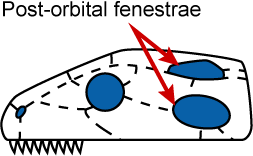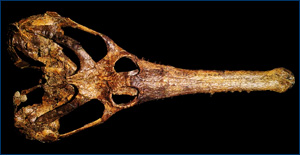
Those diverse diapsids
The reptiles (except turtles)
 A typical diapsid skull featuring the two post-orbital fenestrae, or the "openings behind the eye." |
The evolutionary history of the diapsid lineage is quite complex; diapsids evolved into many shapes, occupying many different ecological niches since they first came onto the scene in the late Carboniferous Period (roughly 350 million years ago), when they were represented by the earliest diapsid, the tiny lizardlike Petrolacosaurus. We have found fossils of a multitude of diapsids that swam, slithered, crawled, ran, or even flew since then. They are truly an amazing group — far more diverse than any other comparable vertebrate group except for Actinopterygii (the ray-finned fishes).
What does the word "reptile" really mean?
 The skull of a champsosaur, an extinct diapsid related to the archosaurs. It is an example of convergent evolution with the crocodilians, as it is not directly related to them. |
The term "reptile" may carry a lot of psychological baggage with it, conjuring up outmoded images of slow, stupid, inferior creatures, but it is a valid term applied to the group comprising the first reptile and all of its descendants. By this convention, birds are considered Reptilia, just like bats are mammals and snails are mollusks. Birds are certainly quite different from other living Reptilia, but the traits that modern birds possess were acquired gradually over many millions of years of evolution. The first birds were quite different than modern birds, and looked much more like good traditional reptiles than hawks, doves, or turkeys do.
Find out more about traditional reptiles (except birds) by searching for them in our vertebrate collections online.

Contributions to this page were made by P. David Polly, Rob P. Guralnick, Alan G. Collins, John R. Hutchinson, and Brian R. Speer between 1993 and 1997. Champsosaur skull photo © UCMP.